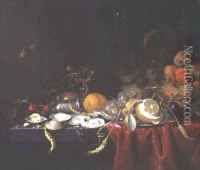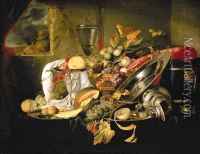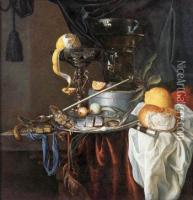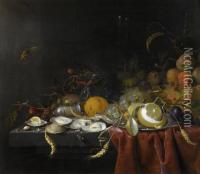Jan Jansz de Heem Paintings
Jan Jansz de Heem, also known as Jan Davidsz de Heem or simply Jan de Heem, was a prominent Dutch still-life painter during the 17th century. He was born in Utrecht, the Netherlands, in 1606 and became one of the most significant still-life specialists of his time, particularly noted for his lavish and intricate representations of flowers and fruits.
De Heem's early life and training are not well-documented, but it is known that he was influenced by Balthasar van der Ast, who was his brother-in-law. Van der Ast was known for his still-life works featuring shells and flowers, and his influence is evident in de Heem's early pieces. However, de Heem would go on to develop his own distinct style that was characterized by a sumptuous richness and complexity.
In the 1630s, de Heem moved to Antwerp, which was then a major center for art and commerce. In Antwerp, he became a master in the Guild of Saint Luke and was influenced by Flemish Baroque, which was prevalent in the region. His work from this period began to exhibit the detailed texture and color that he would become famous for. De Heem's still lifes often combined objects of contrasting textures, such as metal, glass, and various types of food, arranged in a way that showcased his skill in rendering materials.
Jan de Heem's mastery lay in his ability to depict the interplay of light and color and his meticulous attention to detail. He was particularly adept at capturing the translucency of fruit skins, the reflective properties of glassware, and the complex arrangements of flowers in bouquets. His compositions were often elaborately constructed, with a strong sense of order and balance, despite the profusion of elements within the frame.
De Heem's paintings were highly sought after during his lifetime and were collected by wealthy patrons and art lovers. His work had a significant influence on other still-life painters of the era and contributed to the genre's popularity in the Netherlands and beyond.
Throughout his career, de Heem enjoyed success and acclaim. In his later years, he split his time between Antwerp and Utrecht, continuing to work until his death in 1684. De Heem's legacy endures, and his paintings can be found in major museums across the world, where they continue to be admired for their vibrancy and the skillful execution of still-life arrangements.



